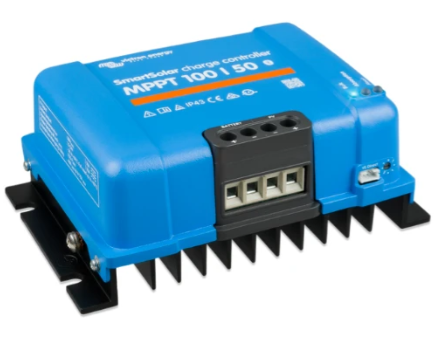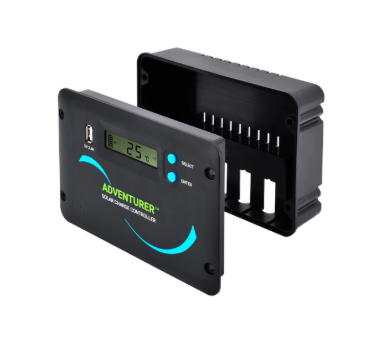
This page was last reviewed:
We strive to keep all information accurate and up-to-date to help you make informed decisions.
MPPT vs PWM Charge Controllers: Everything You Need to Know

Short on Time? Here’s The Article Summary
A solar charge controller, also known as a regulator, is a crucial component in energy storage systems for wind, hydroelectricity, and solar power. It regulates the power sent to the battery, preventing overcharging, which can damage the battery and reduce its lifespan. In a solar system, the controller is placed between the panels and the battery. There are two main types: MPPT and PWM.
MPPT controllers are more efficient and can handle higher input voltages, making them suitable for larger systems and grid-tied setups. They are more expensive but offer better warranties and efficiency. PWM controllers, on the other hand, are simpler and more affordable, suitable for smaller systems where efficiency is less critical. They cannot be used in grid-tied systems and require the solar input voltage to match the battery's voltage. Choosing between MPPT and PWM depends on the size and requirements of the solar system. MPPT is recommended for larger systems, while PWM is suitable for smaller, budget-conscious setups. Proper sizing of the charge controller is essential, typically calculated by dividing the solar array's wattage by the battery's voltage.
Introduction
What is a Solar Charge Controller?
A charge controller, also known as a “solar charge controller'' or simply a “regulator”, is a very important part of an energy storage system in applications like wind, hydroelectricity, and solar. As the energy is produced from the wind, water, or sunlight, a charge controller is used to regulate the amount of power that is sent to the battery. In a solar system, the charge controller is wired directly between the solar panels and the battery. If you are using a solar power generator, it is likely the charge controller is built right into the system.
Why Do You Need a Solar Charge Controller for a Solar Energy System?
Without a charge controller, all of the energy produced by the solar panels is sent directly to the battery or battery bank. If the storage is already full, adding extra power to the system will lead to overcharging, which can cause damage to the battery, reducing its performance and creating a potential safety risk. To ensure the longevity of electricity production, the charge controller is critical in maximizing the life of your solar batteries.
How Do Solar Charge Controllers Work?
In order to prevent overcharging, charge controllers simply monitor the storage level of the battery or battery bank. When the battery voltage rises to a certain level near capacity, the controller will momentarily stop or lower the supply of power going into the storage. Although they are built to serve the same purpose, It is this step in which it is important to know the differences between the two main types of modern solar charge controllers: MPPT & PWM.
The Differences Between MPPT & PWM Charge Controllers
In modern solar energy systems, charge controllers use two main kinds of technology to regulate the flow of power to the battery: Maximum Power Point Tracking (MPPT) and Pulse Width Modulation (PWM). The key difference between the two devices is that MPPT charge controllers have the ability to vary the amount of input voltage being sent to the battery to maximize the charging power, whereas PWM charge controllers are more like a simple switch that will slowly lower the amount of charge being sent to the battery as it approaches full capacity.
MPPT Charge Controllers

Maximum Power Point Tracking (MPPT) charge controllers are essentially “smart” DC-to-DC transformers. They are the newest technology available for DIY solar systems. In most cases, MPPT charge controllers are said to provide the most efficient possible solar charging by converting excess voltage and minimizing overall power loss. MPPT charge controllers are great for large or growing systems and are currently the only technology available to use in a grid-tied solar energy system.
Pros of MPPT Charge Controllers
- Able to handle higher input voltage from large arrays
- Can be used for grid-tied, battery-backed solar systems
- Great warranties, typically longer than PWM charge controllers
- More efficient charging, ranging from +20% to +30%, depending on conditions
Cons of MPPT Charge Controllers
- High cost, often double the price of PWM charge controllers
- Usually large in size, potential to take up valuable space
- Can be difficult in sizing appropriately
PWM Charge Controllers

Pulse Width Modulation (PWM) charge controllers are a well established technology that have been used in the solar industry for years. By slowly limiting the amount of charge being sent to the battery, PWM are able to fully charge a solar battery, without overcharging it. When using a PWM charge controller, the solar battery and PV array should match (i.e. a 12 volt battery and a 12 volt array). Although they are not as efficient as MTTP charge controllers, they are practical for smaller solar systems due to their affordability and simplicity.
Pros of PWM Charge Controllers
- Low cost, rarely more than a few hundred dollars
- Technology that has been used for many years
- Highly variable in size, can be quite small
- Most are built to be extremely durable
Cons of PWM Charge Controllers
- Cannot be used in conjunction with a grid-tied solar system
- Requires solar input voltage to match the battery’s voltage
- Inability to add capacity for an upgraded panel system
- Maximum size of 60 AMPs
How to Choose the Correct Type of Charge Controller
Choosing between PWM or a MPPT charge controllers should be quite simple. If you are charging a battery for a large solar panel system on your home, RV, or van, a MPPT charge controller is the best overall choice. Although they are more expensive, if you are depending on solar energy to power the things you need, maximizing the efficiency and longevity of your solar system can be achieved by using a MPPT charge controller. It is also the only option if your system is tied to the utility grid. A PWM charge controller can be used for small budgets, small solar systems, or in low-use instances in which charging efficiency is not of great concern.
Within each category of charge controller, there are many different brands and capabilities available for all budgets and system requirements. Most high quality solar charge controllers will have a display screen showing various features such as battery temperature, charging status, and percentage of capacity charged.
How to Choose the Correct Size for Your Charge Controller
Choosing the correct size for your charge controller is fairly easy and can be done with a simple formula. Because wattage divided by voltage is equal to amps, to find the correct size charge controller, simply divide the wattage of the solar array by the voltage of the battery. If you have a 600 watt solar system, divided by a 12 volt battery, that leaves you with a 50 Amp charge controller. In sizing any component of your solar system, it is smart to err on the side of caution, so increasing the size to a 60 Amp charge controller is recommended. More information about correctly sizing the parts of your solar energy system can be read in our solar charge controller guide.
Are you ready to look into solar charge controllers?
You can browse our selection of handpicked solar charge controllers.
Still not sure which charge controller is right for you?
You can set up a free solar kit consultation with one of our DIY Solar Experts.
The Ultimate Solar + Storage Blueprint (Mini Course)
Struggling to understand how solar + storage systems actually work? Looking to build or buy your own solar power system one day but not sure what you need? Just looking to learn more about solar, batteries and electricity?
Join 15,000+ solar enthusiasts breaking free from their energy dependence with this short step-by-step video course that will make you a solar + storage expert. Start your journey to energy independence today.
Who is ShopSolar.com?
ShopSolar.com is the #1 digital platform that enables consumers & businesses to source and purchase complete solar + storage solutions direct, saving you thousands in time, energy and money! With over 40,000+ happy customers, we’re on a mission to make solar simple, transparent and affordable.




Leave a comment